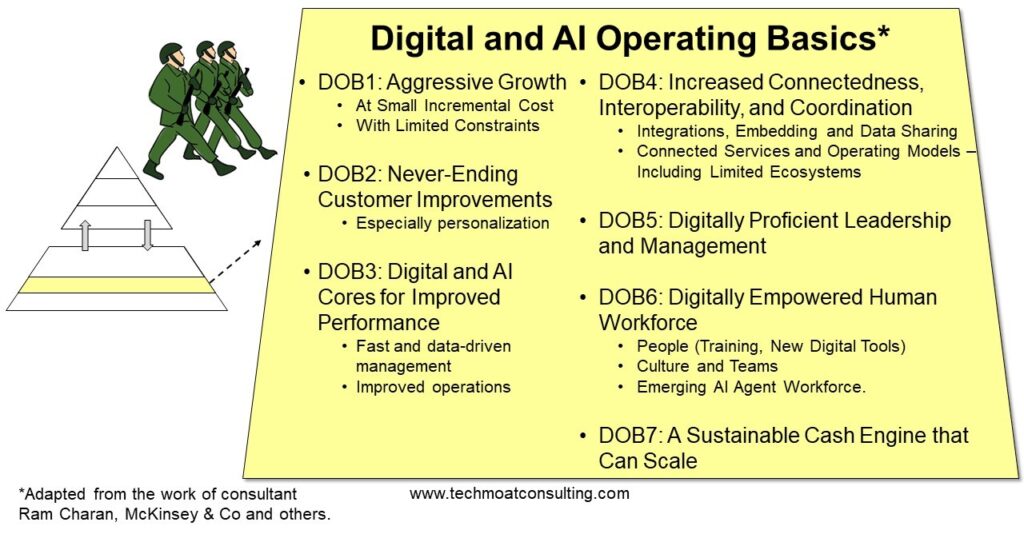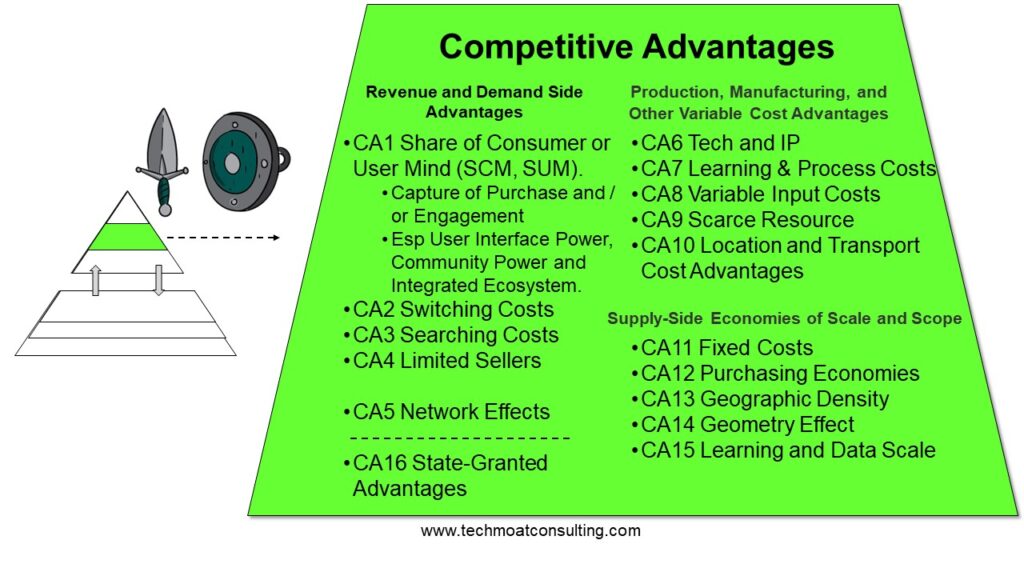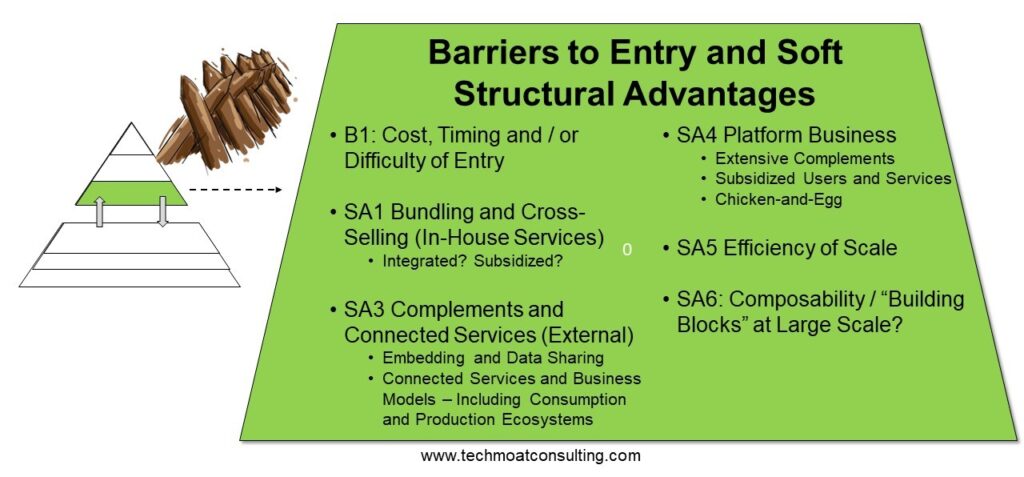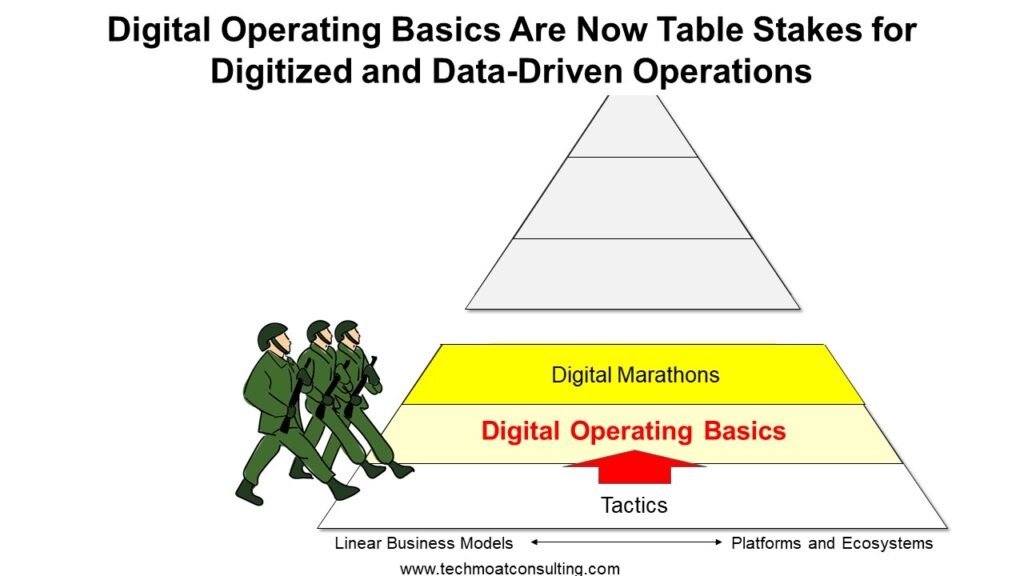Digitalization has compelled businesses across industries to rebuild their operational foundations. It is confusing. And it seems endless. There are always new tools emerging.
My simple summary for this is the Digital Operating Basics (DOBs).
I’ve gone through this before in many podcasts and articles. But it’s basically 7 things you need to do to digitize. These are the basic operating requirements of a digital or digitizing business. It looks like this.

But there are some things people often get wrong. Which can hinder effective implementation and undermine the benefits. This article has 5 of these common mistakes.
Mistake 1: Thinking Digital Operating Basics Are Sources of Competitive Advantage
This is super common.
When businesses point to competitive advantages, they often point to specific DOB activities, like personalization. Or achieving digital scale. They cite these as sources of competitive advantage.
But DOB are almost never moats. They are the operating basics, which means they are the basic requirements. These are table stakes for being in a digital or digitizing business. These are the new basics of operating performance.
For moats, I use different lists. One for barriers to entry. And one for competitive advantages. Here they are:


DOBs are the “operating performance you have to achieve to be competitive” rather than structural barriers or unique capabilities that create a lasting edge.
The analogy I use is of a horse race. Some horses are naturally faster (structure, business model), while some jockeys are more skilled (operating performance). A good jockey can optimize the performance of a horse, but even the best jockey cannot make a slow horse win against a much faster one.
Similarly, excellent execution of DOBs (the skilled jockey) can make a business more efficient and effective, but it doesn’t usually create the structural advantages (the fast horse), like network effects or high switching costs.
Therefore, companies must understand that while mastering DOBs is crucial for survival and effective operating performance in the digital world, it is not a substitute for developing genuine structural advantages that create defensibility and long-term advantages.
Mistake 2: Thinking Digital Transformation and Implementing DOBs are One-Time Projects
Another common mistake is viewing digital transformation, and by extension the implementation of Digital Operating Basics, as a finite project with a clear start and end date. Unfortunately, this is not true.
Building the digital operating basics is not a one-time undertaking. It is an “it doesn’t ever really stop” process of continuous development and refinement. Running a digital business is about building, rebuilding, and improving the foundational infrastructure forever.
What constitutes the “basic” digital operations today (my list of 7 DOBs) might become outdated or insufficient tomorrow. In fact, this DOB list is certain to change over time. For instance, the surge of generative AI tools has created a new imperative for scaling computing power through cloud services.
What’s more, digital transformation is not just about technology implementation but also about changing how a business operates. Digital transformation is a lot about putting tech tools into restructured workflows. And into staff training.
For example, management almost always needs to become more data-driven in decision-making. Achieving shifts in mindset and processes requires continuous effort and cultural adaptation, which cannot be achieved through a one-off project. An example of this is the case of Majid Al Futtaim, which I wrote about here. This large UAE-based retailer underwent a multi-year journey of organizational and cultural change alongside its technological advancements.
Overall, businesses must adopt a mindset of continuous improvement and recognize that implementing DOBs is an ongoing journey of adaptation and evolution, rather than a discrete project to be completed.
Mistake 3: Thinking the Digital Operating Basics are Only Relevant for Digital Natives
The Digital Operating Basics are not just the domain of technology companies or digital natives. And with limited applicability to more traditional businesses, such as retailers and CPG brands. Digital transformation is pretty much required by every business,
As businesses “go digital,” regardless of their origins (retailer, media company, bank, manufacturing, agriculture, healthcare), they first become data driven. And then they become increasingly smart and automated in their operations and workflows.
This tends to be easier for digital natives. Because they were born digital and are already highly data driven and digital in operations.
For traditional businesses, this is much more work. They need to implement DOBs into their existing operations and decision-making. While their traditional operating activities (inventory management, supply chain) remain important, they must be augmented with digital equivalents or digitally enabled processes to achieve efficiency, responsiveness, and customer engagement. It’s a lot of work. It’s like fixing a car while it’s still driving.
Even in sectors lagging in digital adoption, such as agriculture, manufacturing and healthcare, the trend towards data-driven operations and digital workflows is steadily advancing. The core principles of leveraging data for better decision-making (DOB3) and improving customer experience through personalization (DOB2) are universally applicable.
Mistake 4: Not Separating Tactical Actions from the Digital Operating Basics
Another area of confusion lies in the distinction between short-term tactical actions and the Digital Operating Basics.
I describe tactics as “just do whatever works”, such as running a sale, launching a promotion, and refurbishing a store. You just do whatever you need to do to make your sales. Or solve your problem.
Tactics are characterized by their flexibility and responsiveness to immediate circumstances, often competitor or customer actions. My standard picture for Tactics is a never-ending street fight. You get hit and you hit back.

In contrast, Digital Operating Basics involve taking the things that work and standardizing them. DOB is about building more regimented and systematic operations around certain core activities. My standard graphic for this is a regimented line of soldiers, not a street fight.

So, DOBs represent the establishment of core, repeatable activities that underpin the ongoing functioning of a digital-first business. Examples include efficient inventory management, continuous A/B testing for user experience optimization, or systematic data collection and analysis for personalized recommendations.
While tactics are important for responding to immediate market dynamics and exploring new opportunities, they do not constitute the foundational capabilities provided by well-defined DOBs. Relying solely on tactical maneuvers without building underlying systematic operations can lead to fragmented efforts and a lack of sustained improvement.
Businesses must focus on building robust and repeatable Digital Operating Basics to create a strong foundation for sustained digital performance, rather than solely relying on isolated tactical initiatives.
Mistake 5: Thinking the Digital Operating Basics Are Primarily a Technology Effort
Finally, there is always an overemphasis on technology in implementing Digital Operating Basics. While the right technological infrastructure is undoubtedly essential, the human, cultural, and workflow aspects are almost always the more critical and challenging parts.
You’ll note that 2 of the DOBs are about people. There is “leadership and management” (DOB5) and “people, culture and teams” (DOB6). These are usually the biggest bottlenecks in the transformation process.
I’ve written about a “digital divide“ in management and organizations. This when the leaders (both management and boards) lack a solid understanding of digital principles and fail to adapt their thinking and behavior. You can see a big divide in company performance between management teams that have and don’t have digital-first behavior.
I use the analogy of Neo in “The Matrix” movie for this. This is when he tries to jump between two buildings and falls. And Cypher then says, “everybody falls the first time”.
It’s the same for management embracing new digital ways of operating. Management teams always fail the first time. In fact, failing regularly is part of the process of being digital-first. And that is generally something traditional businesses have a hard time accepting. Avoiding failure is a big part of how you rise to the top of a traditional business.
So, crossing the digital divide is a lot about adopting a management culture of experimentation and learning.
I talk to a lot of businesses about how to build a data-driven and experimental culture (part of DOB6). This is essential for leveraging the potential of digital operations. You are constantly trying stuff and re-assessing. Usually this means:
- Empowering teams.
- Encouraging experimentation (even if it leads to failures).
- Fostering a mindset of continuous improvement based on data insights.
Ultimately, the asset that matters most is usually people.
This is a big contrast to the importance of physical assets in traditional manufacturing. Acquiring and developing digital talent, fostering collaboration within teams, and cultivating a supportive and adaptable culture are indispensable for the successful implementation of Digital Operating Basics.
While technology provides the tools and infrastructure for digital operations, the true success of implementing DOBs hinges on addressing the human capital challenges, including leadership alignment, talent development, and cultural transformation.
***
That’s it.
Cheers, Jeff
——–
From the Concept Library, concepts for this article are:
- DOB
- Digital Transformation
From the Company Library, companies for this article are:
- n/a
Photo by Sammie Chaffin on Unsplash
———
I am a consultant and keynote speaker on how to accelerate growth with improving customer experiences (CX) and digital moats.
I am a partner at TechMoat Consulting, a consulting firm specialized in how to increase growth with improved customer experiences (CX), personalization and other types of customer value. Get in touch here.
I am also author of the Moats and Marathons book series, a framework for building and measuring competitive advantages in digital businesses.
This content (articles, podcasts, website info) is not investment, legal or tax advice. The information and opinions from me and any guests may be incorrect. The numbers and information may be wrong. The views expressed may no longer be relevant or accurate. This is not investment advice. Investing is risky. Do your own research.
